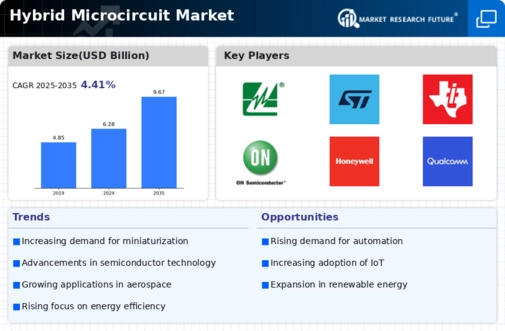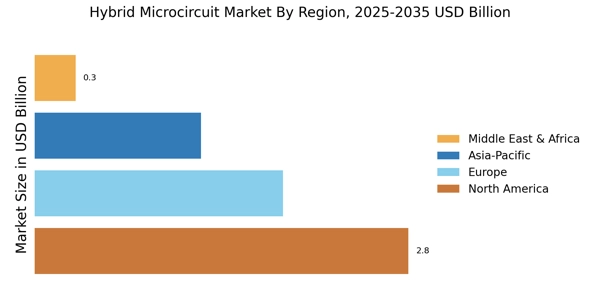Sustainability Initiatives
Sustainability initiatives are becoming increasingly relevant within the Hybrid Microcircuit Market. Manufacturers are adopting eco-friendly practices to minimize environmental impact, which is influencing purchasing decisions among consumers and businesses alike. The shift towards sustainable production methods, such as the use of recyclable materials and energy-efficient manufacturing processes, is gaining traction. This is particularly important as regulatory bodies impose stricter environmental standards. Companies that prioritize sustainability are likely to gain a competitive edge, as they appeal to a growing demographic that values corporate responsibility. Additionally, the market is witnessing a rise in demand for products that are not only efficient but also environmentally friendly, suggesting that sustainability will play a crucial role in shaping future market dynamics.
Growing Demand in Emerging Markets
The Hybrid Microcircuit Market is witnessing a notable increase in demand from emerging markets. Countries in Asia and Latin America are experiencing rapid industrialization and urbanization, leading to a heightened need for advanced electronic components. This trend is particularly pronounced in sectors such as automotive, healthcare, and telecommunications, where hybrid microcircuits are essential for the development of innovative products. Market analysts indicate that the Asia-Pacific region alone is expected to account for a significant share of the market, driven by rising disposable incomes and a growing middle class. As these economies continue to expand, the demand for hybrid microcircuits is likely to increase, presenting lucrative opportunities for manufacturers and suppliers in the industry.
Integration of Internet of Things (IoT)
The integration of Internet of Things (IoT) technologies is significantly influencing the Hybrid Microcircuit Market. As more devices become interconnected, the need for efficient and compact microcircuits is paramount. Hybrid microcircuits are uniquely positioned to support the diverse functionalities required by IoT applications, such as sensors, communication modules, and data processing units. This trend is driving innovation in the design and manufacturing of microcircuits, as companies strive to meet the demands of a rapidly evolving technological landscape. The proliferation of smart devices across various sectors, including home automation and industrial applications, is expected to propel market growth. Analysts predict that the IoT sector will contribute substantially to the overall expansion of the hybrid microcircuit market, as it necessitates advanced solutions that can handle complex tasks in a compact form factor.
Technological Advancements in Electronics
The Hybrid Microcircuit Market is experiencing a surge in demand due to rapid technological advancements in electronics. Innovations in materials and manufacturing processes are enabling the production of more compact and efficient microcircuits. For instance, the integration of advanced semiconductor materials is enhancing performance while reducing power consumption. This trend is particularly evident in sectors such as telecommunications and consumer electronics, where the need for high-performance devices is paramount. As a result, the market is projected to grow at a compound annual growth rate of approximately 8% over the next five years, driven by these technological improvements. Furthermore, the increasing complexity of electronic systems necessitates the use of hybrid microcircuits, which can accommodate multiple functionalities within a single package, thereby streamlining design and production processes.
Increased Investment in Research and Development
Increased investment in research and development (R&D) is a key driver of growth in the Hybrid Microcircuit Market. Companies are allocating substantial resources to innovate and enhance their product offerings, aiming to stay competitive in a rapidly evolving market. This focus on R&D is leading to the development of next-generation hybrid microcircuits that offer improved performance, reliability, and functionality. Furthermore, collaboration between industry players and academic institutions is fostering innovation, resulting in breakthroughs that could redefine market standards. The emphasis on R&D is particularly evident in sectors such as aerospace and defense, where the demand for high-performance microcircuits is critical. As investment in R&D continues to rise, it is likely to yield new technologies that will further propel the growth of the hybrid microcircuit market.

















Leave a Comment